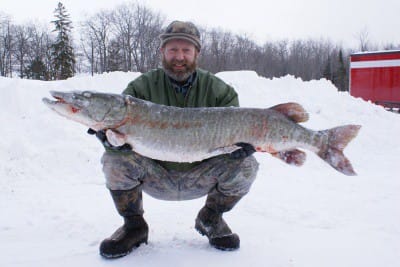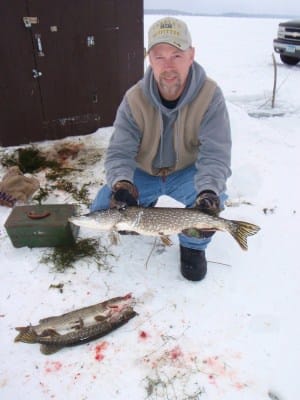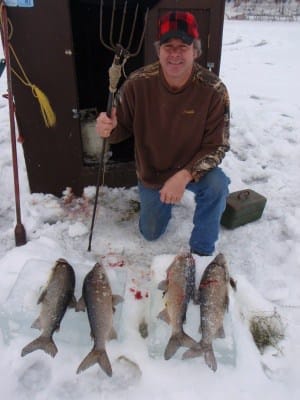 Some people enjoy fishing. Others prefer hunting. Some like to combine fishing and hunting and choose to spear fish. Spearing fish through the ice is something fishermen have been doing in cold climates for generations. Species like pike and musky are the most sought after by fishermen, but in Michigan, sturgeon are also speared.
Some people enjoy fishing. Others prefer hunting. Some like to combine fishing and hunting and choose to spear fish. Spearing fish through the ice is something fishermen have been doing in cold climates for generations. Species like pike and musky are the most sought after by fishermen, but in Michigan, sturgeon are also speared.
Many refer to the sport as “dark house spearing” because it is done from a dark shanty that is often painted black. Inside the shanty all that can be seen is light given off from the large hole cut in the ice. A fish decoy is placed in the water to entice fish to come to the hole to be speared. When the fish approach what they believe is a baitfish, they get speared by the angler who is peering into the hole. Light shining into the hole, movement or noise will spook the predatory fish, so anglers must remain bone still and use a dark-colored shanty so the fish can’t see light or the shadow from the angler sitting over the hole.
If this sport sounds enjoyable to you, you’ll be happy to hear that getting started is simple. Tim Anderson, from Brainerd, Minnesota, owns and operates Big Fish Hunt, a guiding service that specializes in catching large pike, walleye and musky during the summer. During the winter he spears pike for fun with his friends.
Start with a good shanty.
“Most of us use permanent shanties and keep them in the same place for weeks at a time,” Anderson said. “However, I think a portable pop-up style shanty could work if it was black. The problem is portable shanties might not be as comfortable to spear from because they aren’t designed for spearing. The seats are set up for jigging fish.”
Most fishermen move their shanties after a week or two to a new location because often fish will grow accustomed to seeing the decoy in the same place repeatedly and shy away from it.
A good spear is a necessity.
“Many spears aren’t very good. Several of us in Minnesota have our spears made by a blacksmith,” Anderson explained. “I prefer a spear that glides well through the water, is well-balanced and is a bit on the heavy side so when it hits the fish it penetrates into the fish and gets the job done.”
Anderson’s spear weighs about 8 or 9 pounds.

Having a decoy that looks realistic in the water, swims well and catches the eye of predatory fish is important. Most people who are serious about spearing fish buy custom-made decoys from decoy carvers. Bob Johnson from Minnesota is one of the best-known carvers in the country. He has won several national and world carving titles. He says having a decoy that is the right color that swims well in water is important.
“A well-built decoy will be well balanced in the water because the lead in the body is properly positioned which results in a decoy that swims and glides through the water like a real fish,” Johnson said. “My favorite is a red and white decoy. Most people who spear also prefer this color.”
Johnson believes fish easily see the bright red and white colors in the water which often attracts them to the decoy.
Decoy size is important. Some anglers like Johnson prefer large decoys because they hope to entice large fish near the hole. Johnson likes decoys more than 10 inches long. Anderson, however, prefers smaller decoys.
“I go after 3- to 5-pound pike that are good eating, so I use decoys that are as small as 3 inches long that smaller pike won’t be intimidated by,” Anderson said. “Small fish will hit big decoys but don’t always. I’ve had the best luck with smaller decoys.”
Anderson also ties on a spinner to his decoy to add a little flash which attracts the pike.

Motion is added to decoys by raising and lowering the fishing line attached to the decoy. The decoy can be raised and lowered by moving it in a circular motion so it swims around the hole. In most cases, the hole in the ice is about 3×5 feet, which provides plenty of space for the decoy to swim, and the guy with the spear in his hand has plenty of area to see the fish and spear it.
When spearing a fish, Anderson prefers to spear it as it is swimming away from him. As it swims through the hole, he can spear it behind the head without the fish seeing the motion.
“I always have a spear in the water ready to go. After the fish swims through the hole toward the decoy, I spear it,” Anderson said.
In Michigan, fishermen can spear lake sturgeon. On Black Lake in northern Michigan, there is a spearing season in February. When the season opens, only five sturgeon can be taken. After a quota is met, the season closes. Brenda Archambo, from Sturgeons for Tomorrow, says there is nothing like seeing a 100-pound or larger fish being pulled up through the hole in the ice.
“We have large holes, and we use big decoys. Sturgeon are curious fish, so large items in the water attract them. Some hardcore folks use a large bowling ball as a decoy. Almost anything attracts them,” Archambo said.
Regardless of what you spear, you will have lots of fun when you combine the arts of hunting and fishing on a frozen lake.



